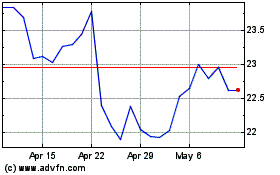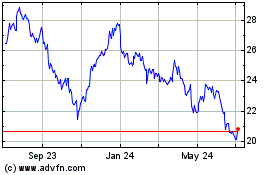Sherwin-Williams Co. has agreed to buy Valspar Corp. for more
than $9 billion, a deal that would help the paint maker get better
access to big-box retailers like Lowe's, where Valspar is a big
seller, and expand abroad.
Sherwin-Williams will pay $113 a share in cash, a 35% premium to
Valspar's closing price on Friday. Based on a fully diluted share
count, which typically includes instruments that can be converted
into stock, the deal is worth about $9.3 billion.
Valspar shareholders already have made out well, with the stock
more than doubling in the past five years, far outstripping the
S&P 500 index.
The Wall Street Journal reported earlier Sunday that the
companies were in talks to combine.
The purchase would give Sherwin another brand and more access to
do-it-yourself painters, who tend to buy their supplies at big
retailers rather than at the contractor-oriented stores owned by
Sherwin.
Retailers such as Home Depot Inc., Lowe's Cos. and Wal-Mart
Stores Inc. have been taking market share away from independent
paint stores.
Valspar is particularly strong at Lowe's and Ace hardware
stores. Sherwin has long relied heavily on its own stores for paint
sales, but last year began selling a new HGTV brand at Lowe's,
taking some space from rivals, such as Valspar.
The deal also would help Sherwin take a larger chunk of global
paint sales. The company's long-standing logo shows a can of red
paint being poured over a globe, bearing the slogan, "Cover the
earth."
Mostly, though, the Cleveland company has covered the U.S.,
which accounts for about 84% of its sales. The Valspar acquisition
would reduce the U.S. share to about 76% by adding sales in Asia
and Europe, according to the company.
"It gives us the scale and platform" to expand in Europe and
Asia, Chief Executive John G. Morikis said in an interview Sunday.
He was promoted to CEO effective Jan. 1, succeeding Christopher
Connor.
Valspar sells paint for houses and buildings—what it calls
architectural coatings—in China and Australia, where Sherwin hasn't
had any significant presence in that product line. Valspar also has
strength in two other areas that Sherwin has been absent from:
coatings for food and beverage packaging and for steel coils.
The combined Sherwin and Valspar would have had coatings sales
last year of about $15.6 billion, outstripping rival PPG Industries
Inc.'s $14.2 billion and Amsterdam-based AkzoNobel NV's $11.1
billion, according to Sherwin.
The global coatings market—including paint and coatings used on
cars, ships and myriad other products—generates about $130 billion
of sales a year, according to PPG.
No decision had been made on whether Gary Hendrickson, chairman
and CEO of Valspar, would stay with the combined company, Mr.
Morikis said.
Sherwin valued the Valspar deal at $11.3 billion, including the
assumption of debt.
The deal includes an unusual cut to the purchase price should
antitrust regulators demand aggressive divestitures. If Sherwin is
forced to sell businesses representing more than $650 million of
Valspar's 2015 revenue, the price drops by $8 a share. Sherwin
could walk away entirely if divestitures climb to $1.5 billion of
revenue, a provision that is more common.
The potential price cut is a nuanced way to handle antitrust
risk, which is usually dealt with more bluntly with all-or-nothing
walkaway rights and termination fees.
But it means Valspar shareholders likely would be voting on a
deal without knowing for sure how much they would get paid, which
could complicate approval.
The companies said they believe there is minimal risk of
antitrust pushback and that the provisions "provide
Sherwin-Williams and Valspar with greater closing certainty."
Sherwin said it expects the deal to immediately add to earnings,
excluding one-time costs, and projected $280 million in annual
synergies, which normally come from cutting overlapping
expenses.
It has been a busy stretch for chemical-company mergers, a
category that coatings sellers would fall under. Late last year,
chemicals manufacturers Dow Chemical Co. and DuPont Co. signed a
deal worth a combined $120 billion.
In February, government-owned China National Chemical Corp.,
known as ChemChina, capped a string of acquisitions with a $43
billion deal to buy Swiss pesticide and seed provider Syngenta
AG—the biggest foreign takeover attempt by a Chinese company to
date.
Write to Dana Mattioli at dana.mattioli@wsj.com, Liz Hoffman at
liz.hoffman@wsj.com and James R. Hagerty at bob.hagerty@wsj.com
Corrections & Amplifications: The equity value of the deal
is $9.3 billion. An earlier version of this article calculated the
value based on Valspar's basic share count, instead of the diluted.
(March 20)
(END) Dow Jones Newswires
March 20, 2016 21:15 ET (01:15 GMT)
Copyright (c) 2016 Dow Jones & Company, Inc.
Akzo Nobel NV (QX) (USOTC:AKZOY)
Historical Stock Chart
From Mar 2024 to Apr 2024

Akzo Nobel NV (QX) (USOTC:AKZOY)
Historical Stock Chart
From Apr 2023 to Apr 2024
